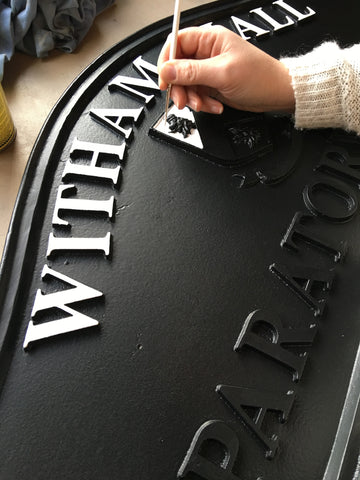The art of sand casting goes back centuries. We enjoy the process of sand casting our signs in the traditional way using authentic time honoured casting methods and finishes.
Owning a Signcast cast sign comes with the assurance of knowing it has been made in the UK by hand from start to finish, which gives your sign a unique blend of old and new, replicating the look and feel of traditional cast signs that have stood the test of time.
We are often asked how signs are made when using the traditional sand cast technique. It is an art at each step of the way and every persons contribution to the sign making process is vital.
It all begins with exceptional customer service in understanding precisely what our customers want and are expecting.
Many people get confused when it comes to the different choice of metals and to have someone on hand to talk things through can be very reassuring.
Once the finer details of the signs design have been decided, it is then time to design the artwork ready for pattern making.
We can design a pattern with a unique sign font or logo, we provide a pattern making service for the creation of a unique pattern formed from our customers artwork or we can prepare your artwork which is emailed for approval before your pattern is made.

Once our customers have approved their design, the pattern is produced.
The pattern is then transferred to our foundry where a sand mould is made and an impression of the pattern formed.
The pattern is removed and the molten metal poured into the space to create one solid cast metal sign (this is very hot work and not for the faint hearted). Once the molten metal has cooled the sand is knocked from the hot cast plaque.

The rough new sign is then taken to the finishing area to be fettled, ground, drilled if necessary to form screw hole fixing areas or threaded if rear fixings have been cast onto the plaque and finally sand blasted to create a smooth surface in preparation for the powder coating to be applied.

The cast signs are then marked with the correct colour chosen at the time of ordering and the signs make their way to the powder coater, where a layer of heavy duty outdoor weather resistant powder coating in a choice of colours is applied.
Finally the powder coated signs are sent into our studio where the final text and maybe motif for decoration is hand painted using tough enamel paints.

If a polished finish has been chosen then they are sent to the polisher to be hand polished, in that case they will then need to return one more time to be powder coated in a lacquer to protect the newly polished surface. If they also have a painted motif this will finally be done at the end stage of production to create a truly unique sign.

The hand painted signs are left to dry for at least a day in order that the paint surface is hard enough to withstand being packaged, the finished plaque is then ready to be photographed in our studio.
In the case of polished brass and bronze signs they are then hand coated in a layer of wax to protect the surface but allow for a further patina to develop.
If ground spikes or back bars are required for railings these are then made to measure on each sign and matched up with the correct fixings.
Our house signs, commemorative plaques, business signs, road signs and award plaques are finally taken to the packing area to be carefully wrapped in recycled packaging materials where possible, often having hand painted or patinated screws made to match the surface colouring.



